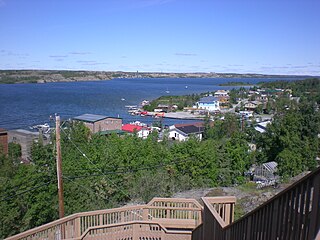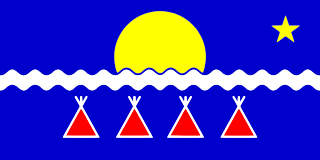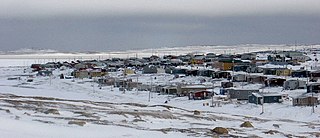
The Northwest Territories is a federal territory of Canada. At a land area of approximately 1,144,000 km2 (442,000 sq mi) and a 2016 census population of 41,790, it is the second-largest and the most populous of the three territories in Northern Canada. Its estimated population as of 2023 is 45,668. Yellowknife is the capital, most populous community, and only city in the territory; its population was 19,569 as of the 2016 census. It became the territorial capital in 1967, following recommendations by the Carrothers Commission.

Yellowknife is the capital, largest community, and only city in the Northwest Territories, Canada. It is on the northern shore of Great Slave Lake, about 400 km (250 mi) south of the Arctic Circle, on the west side of Yellowknife Bay near the outlet of the Yellowknife River.

The Tłı̨chǫ people, sometimes spelled Tlicho and also known as the Dogrib, are a Dene First Nations people of the Athabaskan-speaking ethnolinguistic group living in the Northwest Territories of Canada.

Sanikiluaq is a municipality and Inuit community located on the north coast of Flaherty Island in Hudson Bay, on the Belcher Islands. Despite being geographically much closer to the shores of Ontario and Quebec, the community and the Belcher Islands lie within the Qikiqtaaluk Region of Nunavut, Canada.
The Tlicho language, also known as Tłı̨chǫ Yatıì or the Dogrib language, is a Northern Athabaskan language spoken by the Tłı̨chǫ First Nations of the Canadian Northwest Territories. According to Statistics Canada in 2011, there were 2,080 people who speak Tłı̨chǫ Yatıì. As of 2016, 1,735 people speak the language.

Air Tindi is an airline based in Yellowknife, Northwest Territories, Canada. It operates scheduled and on demand charter services. Its main base is Yellowknife Airport and the airline was previously owned by the Arychuk family. The name Tindi means "the big lake" or "Great Slave Lake" in the local native Tłı̨chǫ Yatiì language.
Aurora College, formerly Arctic College, is a college located in the Northwest Territories, Canada with campuses in Inuvik, Fort Smith and Yellowknife. They have learning centres in 23 communities in the NWT. The head office for Aurora College is located in Fort Smith.

Monfwi is a territorial electoral district for the Legislative Assembly of the Northwest Territories, Canada. The district consists of the four Tłı̨chǫ communities of Behchokǫ̀, Gamèti, Wekweètì and Whatì.

Behchokǫ̀, officially the Tłı̨chǫ Community Government of Behchokǫ̀, is a community in the North Slave Region of the Northwest Territories, Canada. Behchokǫ̀ is located on the Yellowknife Highway, on the northwest tip of Great Slave Lake, approximately 110 km (68 mi) northwest of Yellowknife.

Gamètì, officially the Tłı̨chǫ Community Government of Gamètì is a community in the North Slave Region of the Northwest Territories, Canada. Gamètì, according to the Prince of Wales Northern Heritage Centre means "rabbit-net lake". 'Gah means 'rabbit', and "mi" means net, "tì" means lake, or water. It is one of the four Tłı̨chǫ communities which form part of the Tlicho Government.

Wekweètì, officially the Tłı̨chǫ Community Government of Wekweètì is a community in the North Slave Region of the Northwest Territories, Canada. Wekweètì is a Tłı̨chǫ aboriginal community and is located 195 km (121 mi) north of Yellowknife. It has no year-round road access but does have a winter ice road connection; the majority of transportation to and from the community is through the Wekweètì Airport. Wekweètì is the closest community to the Ekati Diamond Mine on the border with Nunavut. Wekweètì is part of the Tlicho Government.

In the summer of 2013, there were several major wildfires in Colorado in the United States. During June and July, record high temperatures and dry conditions fueled the fires all across the state. By July 24, 570 structures had been destroyed and 2 people died. Below is a list of the major fires of the year.

2015 Canadian wildfires were a series of wildfires across Canada and Alaska in July 2015 which spread smoke across most of North America. Over two hundred fires were ablaze across British Columbia, Saskatchewan, and Alberta.

By the end of June 2018, there had been more than 560 wildfires in British Columbia.

The 2019 Alberta wildfires have been described by NASA as part of an extreme fire season in the province. In 2019 there were a total of 803,393.32 hectares, which is over 3.5 times more land area burned than in the five-year average burned. The five year average is 747 fires destroying 146,360.08 hectares. There were 644 wildfires recorded in Alberta. By May 31, 10,000 people had been evacuated, 16 homes, and the Steen River CN railway bridge, had been destroyed.
The 2021 Washington wildfire season officially began in March 2021. By late April, all of Eastern Washington had been classified by the United States Drought Monitor as "abnormally dry" with moderate to severe drought conditions. The state had more than 630 wildfires by the first week of July, on par with the state's record 2015 wildfire season.

The Tiger Fire was a wildfire that burned 16,278 acres (6,587 ha) in the U.S. state of Arizona from June to July 2021. The fire was caused by a dry lightning strike in the Prescott National Forest. Although Horsethief Basin Lake was evacuated and both the community of Crown King and the census-designated place of Black Canyon City were threatened, no injuries or deaths were reported, and no buildings were destroyed. Over 300 fire personnel were assigned to contain the blaze.

Beginning in March 2023, and with increased intensity starting in June, Canada has been affected by an ongoing, record-setting series of wildfires. All 13 provinces and territories have been affected, with large fires in Alberta, British Columbia, the Northwest Territories, Nova Scotia, Ontario, and Quebec. The 2023 wildfire season has seen the most area burned in Canada's recorded history, surpassing the 1989, 1995, and 2014 fire seasons, as well as in recorded North American history, surpassing the 2020 Western US wildfire season.
















